-
Questions?
- zonexsllc@gmail.com
Ants
Some of the most common ants found in Florida
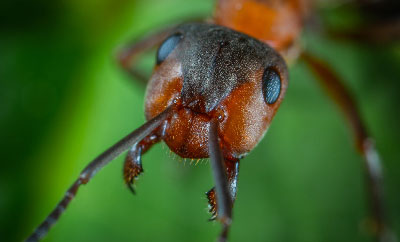
Carpenter Ant
Carpenter ants get their name because they excavate through wood in order to build their nests. They do not eat wood, but forage for sweet and protein-rich foods to maintain and grow their colonies These are large ants – workers range in size from 1/4″-3/4″. All species of carpenter ants primarily target wood that is either wet or damaged. Even though wet or damaged wood is initially their target, they enter structures through cracks around doors, windows, or holes for wires and pipes. They also use overhead power lines and tree limbs that touch nearby structures. Carpenter ants build their main nest outdoors in various wood sources. Carpenter ants do not require wood in order to build a nest; they can also seek out rigid foam or behind fiberglass insulation.
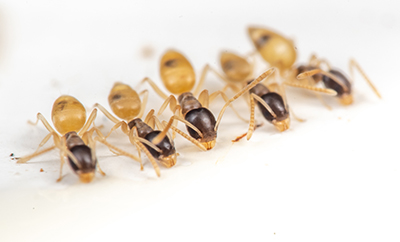
Ghost Ant
These ants can develop very large colonies, with many queens, and colonies can divide or split through a budding process like the pharaoh ant and white-footed ant. Ghost ants readily enter buildings, usually by trailing from nests along guidelines. Ghost ants will enter structures from ground to roof levels. Workers run rapidly trailing along edges and corners. Indoor trails are hidden, under carpet edges and along electrical wires in wall voids. Ghost ants have high moisture needs; they often trail to sinks, commodes and shower stalls. Outdoor trails can be found behind grass and/or mulch lining sidewalks, patios and exterior walls.
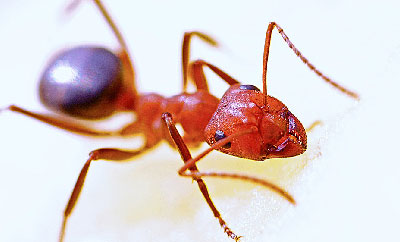
Fire Ant
These ants will build large mound nests and will sting humans who come across their territory. Red imported fire ants will build their nest mounds outdoors in landscape areas or near a structural foundation. The ant will gain entry to a building through holes or cracks and crevices. The sting of a red imported fire ant is painful and often results in a raised welt which then becomes a white pustule. Often, a person stung by a red imported fire ant receives multiple painful stings from more than one of the ants.
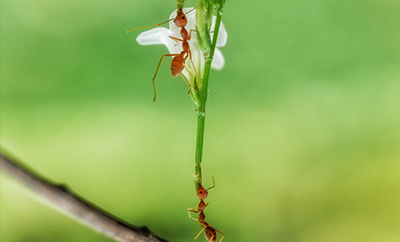
Acrobat Ant
Often nest outdoors under stones, logs, firewood, or trees where decay allows them to tunnel under bark or into wood. Within structures, they nest in wall and floor voids, foam insulation, and other areas commonly associated with carpenter ants. They are found in abandoned termite, carpenter ant, or other wood-infesting insect galleries.
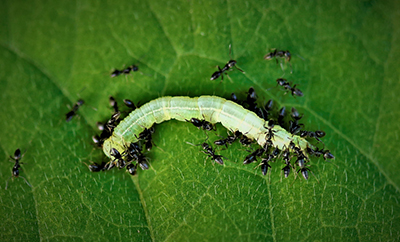
White Footed Ant
Easy-to-find foraging trails outside infested structures. Trails commonly follow structural guidelines, such as edges of sidewalks, edges of brick buildings, and soffit corners. Once inside, workers forage along baseboards above and below carpet edges. White-footed ants prefer sweets. Outdoors, they feed on honeydew and tend aphids, mealy bugs and scales. They nest in piles of wood, stones, heavy vegetation at foundations or in trees. Indoors, they nest in wall voids, potted plants a single colony can encompass many sites, both close by and far away from a single nest. This ant does not bite or sting or cause any structural dama.
Cockroaches
Some of the most common cockroaches found in Florida
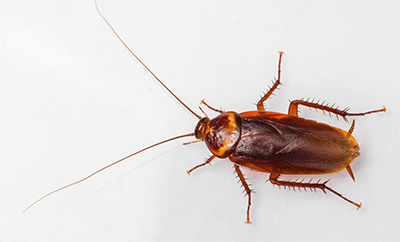
American Cockroach
The American cockroach prefers dark, humid and undisturbed areas and can be found in subfloors, basements, kitchens, roof voids and bathrooms of homes. They forage under appliances, in drains, in kitchen cabinets. They are primarily outdoors; within mulch beds, landscapes and other moist den areas of the exterior property however, it is not uncommon to find them indoors as they search for water or food.
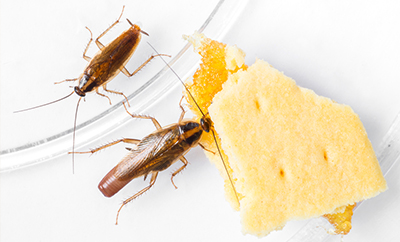
German Cockroach
German cockroaches are the most common species of pest cockroach in the world. Their more than capable to produce more eggs and develop more rapidly than other cockroach species. German cockroaches prefer wet, humid conditions and are typically found in or around kitchen cabinets, dishwashers, refrigerators, stoves and sinks in homes and commercial properties. They frequently enter residential and commercial structures by hitching rides in cardboard boxes, grocery bags, drink containers, and secondhand furniture or appliances.
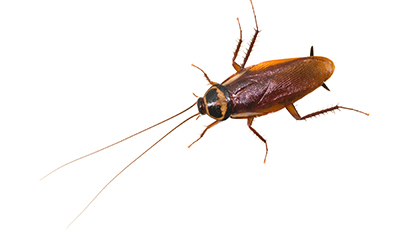
Australian Cockroach
One of several species of cockroaches that live mostly outdoors, but occasionally may be found indoors and the most common cockroach species found outdoors in southern Florida. This species looks similar to the American cockroach but can be distinguished by the presence of light-yellow bands on upper margins of the forewings. A complete life cycle of the Australian cockroach includes the eggs, five nymphal instars and the adult. An ootheca may contain 24 embryos, which require about 40 days to complete embryonic development. It takes about 24 days for a newly molted female to produce the first ootheca. The ootheca is often dropped or glued in hidden cracks and crevices. An adult female can lay about 20-30 egg similar to the shape of a bean in her lifetime. Development to the adult stage requires about one year, with adult females surviving for an additional four to six months.
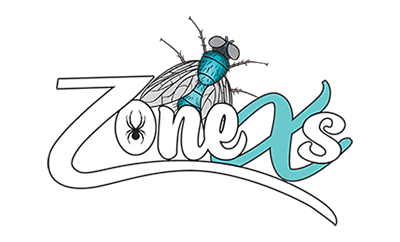
Surinam Cockroach
SIZE: 3/4" COLOR SHINY BLACK HEAD WITH A LIGHT TO DARK BROWN BODY they can end up in your home through houseplants and are transported through plant soil and end up infesting homes and buildings the plants are brought to. The female Surinam cockroach does not fly. The male Surinam cockroach can fly very short distances. Spring, summer, and fall are the most active seasons for the Surinam cockroach.
Ticks
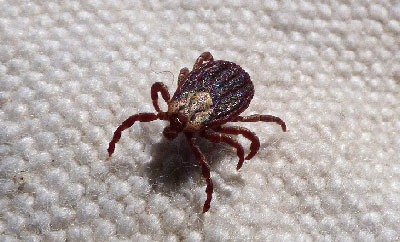
American Dog Tick
American dog ticks are found mostly in areas with little or no tree cover, such as fields, forest, and along walkways and trails. They feed from a variety of hosts such as mice, domestic pets, and humans. They can live up to two years without finding on a host. Starts as an egg and then goes through several stages before maturing. Female dog ticks detach from hosts in order to find areas to lay their eggs. A single female American dog tick can lay up to 5,000 eggs at one time.
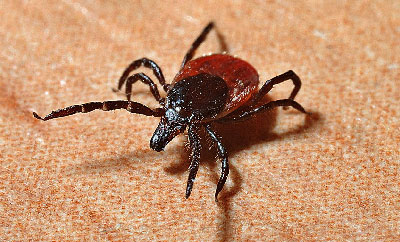
Blacklegged Tick(Deer Tick)
Formerly known as the deer tick, the blacklegged tick is named for its dark legs, which contrast with its pale body. In the spring, female blacklegged ticks will drop from their host to lay their eggs – on average, a female will lay around 3,000 eggs. Nymphs prefer to feed on mice, squirrels, raccoons, dogs, and birds. Blacklegged ticks prefer to hide in tall grasses and shrubs while waiting for a passing host. Blacklegged ticks start as eggs and then go through several stages before maturing. Blacklegged ticks are capable of babesiosis and Lyme disease – disease transmission to a host happens during nymph and adult feeding sessions.
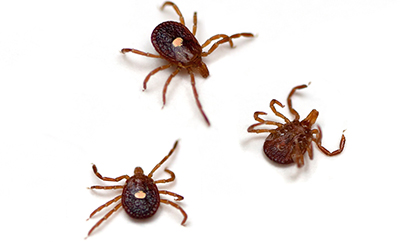
Lone Star Tick
Recognized by deep brown exterior, adult females have a prominent white dot on their backs. Known to spread Rocky Mountain spotted fever, tularemia, and Lyme disease. Commonly found in south-central and southeastern region of the US. Can be found indoors after attaching themselves to humans or their pets. Adults can be found on large animals, cattle, deer, and horses.
Flies
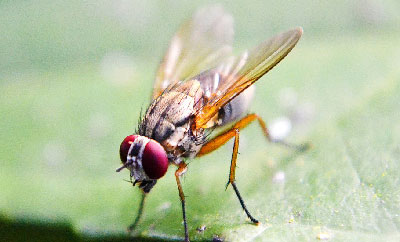
Fruit Fly
Fruit Fly are commonly found in or around kitchens and trash reciprocals in residential homes. Restaurants and other food service facilities often encounter fruit fly problems due to the flies being attracted to liquor, beer and fruit juice blends. They eat and are attracted to ripe/fermenting produce like fruits and vegetables. The average life cycle of a fruit fly is around 25 days long.
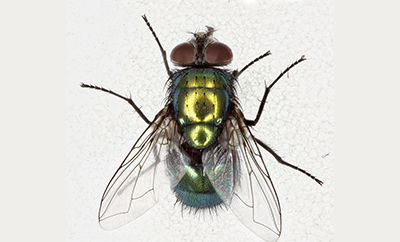
Green Bottle Fly
Green Bottle Fly name originates from their iridescent colors that are similar to colored bottles. Black blow flies have a bluish-green luster; green bottle flies are metallic blue green; blue bottle flies have a metallic blue quality. Adults are 1/4-1/2″ in length. The larva is like house fly larva in all respects except size. Blow fly larvae are 3/4″ when mature. They are easily identified by the metallic sheen of their stout bodies. They are often seen hovering around garbage cans and are attracted to pet feces and dead animals. Blow flies get into homes through open doors, windows, or small cracks in walls in search of food. Once inside, blow flies find a meal and begin to deposit eggs. Females may lay 550 to 2,400 eggs in her lifetime. Eggs are laid on meat, fish, animal manure, garbage or rotting vegetables may be used. Eggs hatch in less than a day and the larvae develop rapidly, molting three times within three or four days. The developmental time from egg to adult takes 10-15 days. As an adult, they live for 7-20 days.
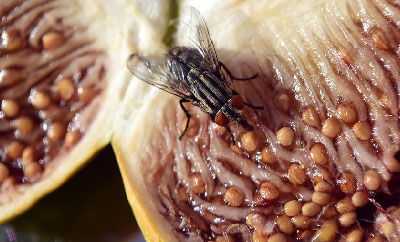
House Fly
House Fly get their name from being the most common fly found around homes. Adult house flies can grow to one-quarter of an inch long and can live between 15 and 25 days. House flies are only able to feed on liquids but can turn many solid foods into a liquid form. House flies’ taste with their feet. Larvae do most of the feeding and live in decaying plant material, animal feces, and trash. House flies tend to stay within 1-2 miles of where they were born; however, they have been known to migrate up to 20 miles to find food. These insects have been known to carry over 100 different kinds of disease.
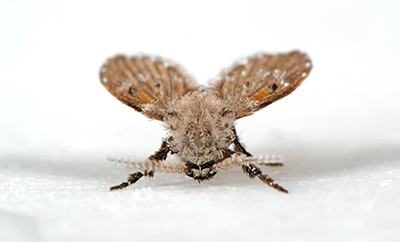
Drain Fly
A drain fly will lay their eggs near broken-down, organic material. In ideal conditions, drain flies are able to produce one generation in about one week. The drain fly poses problems for homeowners when their numbers grow to excessive amounts. Drain flies are commonly found in moist areas like kitchen, bathroom, and storm drains.
Spiders
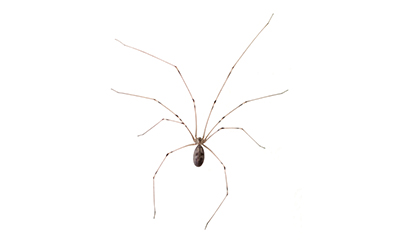
Cellar Spider
Cellar Spider One of the most common spiders found throughout North America. A darkened pattern around the eyes resembling a violin causes misidentification with the brown recluse Commonly found in basements/garage/car ports or other darkened recesses of the home One sign of these spiders is their disorganized webbing that they create.
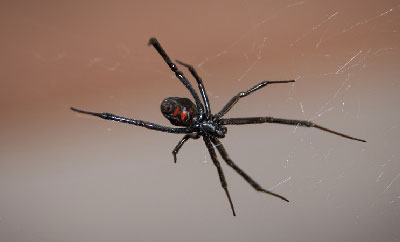
Black Widow
Black widow spiders spin their webs near ground level. They often build their webs in protected areas, such as in boxes and in firewood. Black widow spiders are often found around wood piles and gain entry into a structure when firewood is carried into a building. They are also found under eaves, in boxes and other areas where they are undisturbed. The venom of a black widow spider is a neurotoxin and is used as a defense. The black widow spider bite can cause severe pain.
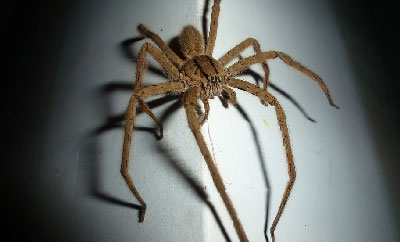
Wolf Spider
Wolf Spider are fast movers and large. Wolf spiders primarily live outdoors, but often seek shelter inside of structures as winter months approach. They don’t spin webs and live on the ground for the most part, although some will make temporary burrows. Wolf spiders are most prevalent in early spring and summer, especially in wooded areas.
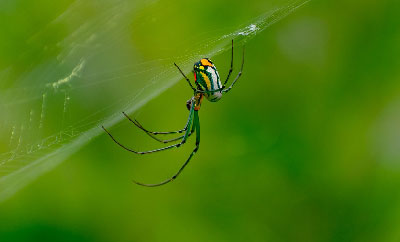
Golden Silk Orb Weaver Spider
Golden Silk Orb Weaver will live anywhere with an ample food supply and structures that will support a web – they are commonly found near light fixtures, on tree branches, tall grasses, and bushes. They are most noticeable in late summer into fall. Orb weavers are a non-aggressive spider that will avoid any danger or threats. Orb weavers are typically nocturnal. During the day, they prefer to remain completely still in their web or close by in leaves or tall grass.
Rodents
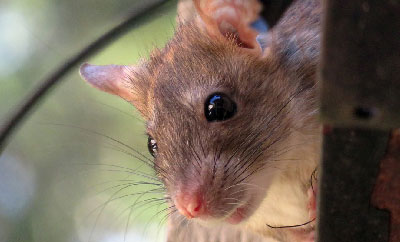
Roof Rat
Roof Rat get their name from their tendency to be found in the upper parts of buildings. They have very poor vision and are color blind. They do have strong senses of hearing, smell, touch and taste. Roof rats are known for the damage they cause within commercial and residential properties. Roof rats can be found in the upper parts of buildings and can also be found under and around structures. They only need a space of one-half inch to get into buildings. Roof rats secured their place in history by spreading the highly dangerous bubonic plague. They support many ectoparasites and urinate on food. One way to prevent rats from entering a property, seal up any holes or cracks larger than a quarter properly. Remove sources of moisture and harborage.
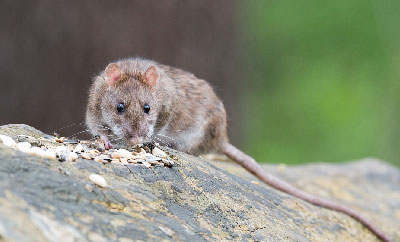
Norway Rat
Norway Rat have small eyes and ears and short tails. Norway rats are primarily nocturnal and often enter homes during the fall months when outside food sources become scarce. Norway rats are known to gnaw through almost anything to obtain food and water. Unlike mice, rats need water to survive. Norway rats are social rodents and build burrows close to one another. Outdoors, Norway rats live in fields, farmlands and in structures. These rats frequently burrow in soil near riverbanks, garbage, in woodpiles and under concrete slabs. Indoors, Norway rats often nest in and around garages, basements, piles of debris. These rodents can gain entry to a home through a hole the size of a quarter. Norway rats can cause damage to structures from their chewing and gnawing. These rats are vectors of diseases and in addition, Norway rats can contaminate food and introduce fleas into a home. The Norway Rat has no season of inactivity. It remains busy throughout the entire year.
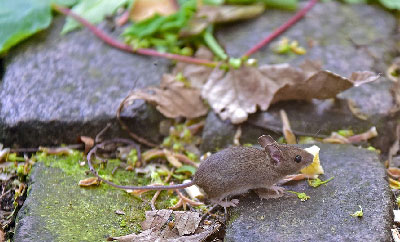
House Mice
House Mice can squeeze through dime-sized cracks to enter homes and buildings. The house mouse size ranges 5-7″ long, including the 3-4″ tail. Female house mice can produce between 5 and 10 liters per year, with each litter containing anywhere from 5 to 12 young. Pregnancy lasts up to 21 days until the hairless, blind, and helpless young are born.
Stinging Insects
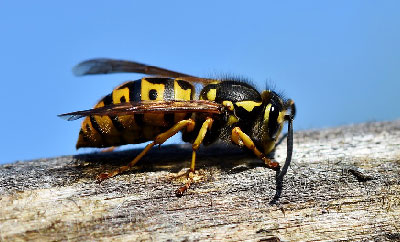
Cicada Killer Wasp
Cicada killers resemble yellow jackets, but it is actually a type of wasp. The cicada killer earns its name from using an actual Cicada as food for its young. The wasp will dig a burrow in search of a cicada, and then begin nesting once one is found. The reproduction of cicada killers can be a little disturbing; the female wasp will sting a cicada and bring it back to her burrow. She’ll bring about one or two back to the burrow and lay an egg on one. The hatched egg will then feed on the cicada until it’s fully grown. Cicada Killers are not a colonizing bug, so they’ll only be found alone in a nesting site. The larvae will grow in their burrows during the winter, pupate in spring, and around July to August it will leave the burrow as an adult. Only the females construct these burrows. Females are also the only ones who can sting but won’t attack someone unless they’re threatened. Most people are stung by cicada killers when they step on them. Males will buzz around but cannot sting. Nesting areas for cicada killers are usually in bare ground and sandy soil. While burrowing, the females excavate a small amount of soil which can cause slight damage to lawns.
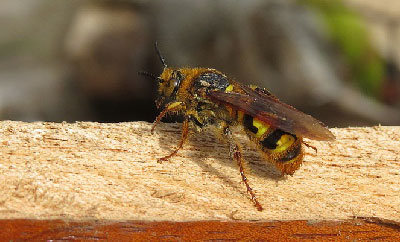
Yellow Jackets
Yellow Jackets prefer to nest either in low hanging aerial nests such as tree limbs, landscape shrubbery, or the corners of structures. Sometimes, yellow jackets will even build nests inside of wall voids. A yellow jacket colony can be upwards of over 1,000 workers. All workers in the colony are females. August is when males begin to appear. Males will die-off when cold weather moves in, but females who are fertilized hibernate over winter to become queens the following season.
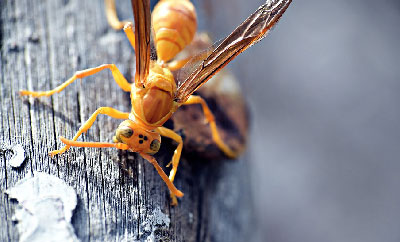
Paper Wasp
Paper wasps get their common name from the paper-like material used to make their nests. Paper wasps are semi-social and live in small colonies. They eat nectar and other insects including caterpillars and flies. Paper wasps hang their comb nests from twigs, tree and shrub branches, porch ceilings, the tops of window and door frames, soffits, and eaves. While not an aggressive species by nature, paper wasps will sting if they are disturbed or threatened. Wasp stings are painful and can cause the same risk of allergic reaction as other insect stinging pests stings.
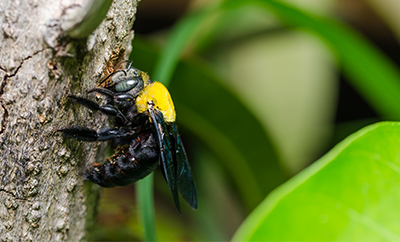
Carpenter Bee
Carpenter bees resemble a typical bumble bee but have shiny and almost hairless abdomens. This bee is solitary, not colonial like a bumble bee. This species gets its name from their habit from drilling into wood like an actual drill producing wood shavings and dust. They can create perfectly circular, 1/2″ holes and elaborate galleries for their young. Carpenter bees do not defend their nests or offspring. Instead, they rely on wood to conceal and protect them. Carpenter bees are a serious threat to exposed lumber, as they can cause extensive structural damage. Male carpenter bees can be territorial and may hover in front of one’s face, but they cannot sting. They have no stinger. Female carpenter bees on the other hand, do possess a potent stinger but rarely ever use it.
Other Insects
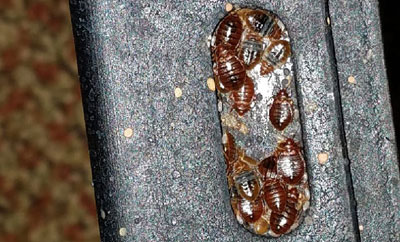
Bedbugs
As their name implies, bed bugs are frequently found in mattresses, on mattress tags, box springs and even in headboards. Bed bugs gain access to people through travel as well as used furniture and bedding, luggage or other objects that move from place to place. They are also found in power outlets, wall voids, upholstered furniture, baseboards, and more. Bed bug eggs are no larger than a couple of grains of sand and white in color. Within her lifetime, a female bed bug could lay up to 500 eggs but typically only lays one to five eggs a day, usually in clusters. An adult bedbug can survive up to one year without a blood meal.

Fleas
Fleas are small, wingless parasites that draw blood from their host. Their bodies are shiny and reddish brown in color and are covered in microscopic hair which allows for easy movement through animal fur. Fleas do not have wings; they can jump extraordinarily long distances. Fleas are usually more annoying than lethal, but they can spread tapeworms to your pet and other family members. The eggs are laid in the fur TYPICALLY 40-50 per day. However, the eggs soon fall off into carpeting, under cushions of furniture, and wherever else the pet’s sleeps, or spends time. Eggs will hatch within a couple of days within the ground, in rugs, carpet, bedding, upholstery, and cracks in the floor.
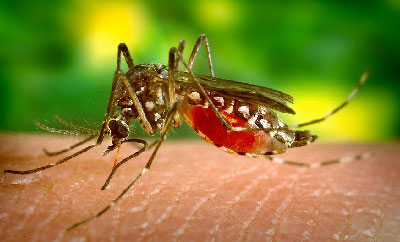
Mosquitoes
There are over 4,000 species of mosquitos. They all share certain common characteristics. All mosquitos have 3 segments including their head, thorax, and abdomen. They have 2 antenna that allow them to sense vibrations and gives them a sense of hearing. Mosquitos have 2 wings that they use to move from place to place. Both male and female have a proboscis, which is a long tubular section they use for feeding. Interestingly, female feed on blood from animals and humans, while males feed on nectar and plant juices. A female mosquito can lay up to 100 eggs at one time. Females lay their eggs in stagnant bodies of water that can be as large as a pond or as small as a puddle. Within 7-10 days, larvae molt 3-4 times and then enter the pupae stage. At this stage, you can see them moving around in the stagnant water. Once fully developed, the larvae will become adult mosquitos, dry their wings and fly away. The entire life cycle takes about 10 days to emerge as an adult.
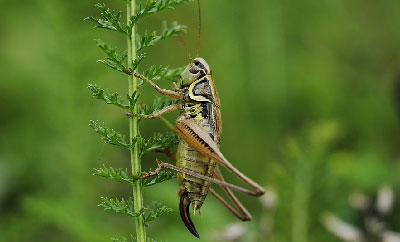
Crickets
Most common cricket is the field cricket, though over 100 species, including house crickets, the invasive camel cricket and mole crickets, can also be found in and around households. Typically, black or dark brown, crickets have also been known to appear yellow in color. The house cricket is distinguishable by the three dark bands on the head. Crickets grow to lengths of about 1/2 – 3/4″. Males chirp by rubbing their wings together, with most activity taking place at night.
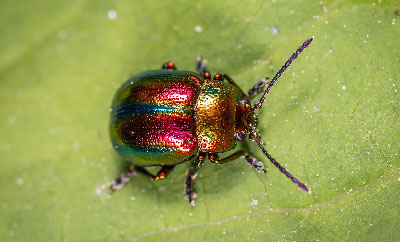
Beetles
Beetles make up the largest category of insects in the world, account. In fact, there are more than 5 million different species of beetles. Beetles are easily identified by their hard-outer shell, which covers their wings. Their wings are exposed only during flight. A beetle’s body consists of three sections: a head, a thorax, and an abdomen. Adult beetles do not eat wood, only the beetle larvae do. When you see holes in either structural wood or in furniture, it is because the larvae have already left, and you are seeing the exit holes. Some beetles, such as the common Ladybug, are advantageous to have around. They are known to keep down the population of other insects, so you should not attempt to destroy them or any other beneficial beetle species.
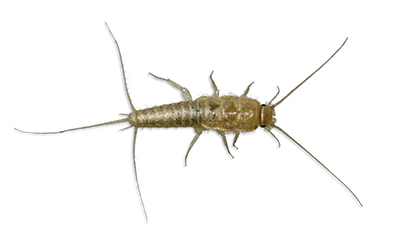
Silver Fish
Silver Fish gets its name from its silvery, metallic appearance and fish-like shape and movements. Silverfish have no wings but can run very fast. Silverfish tend to feed on paper items, glue, linen cloth, food items, such as flour and rolled oats. Silverfish can live up to one year without food but require high humidity environments – they are often found in bathrooms, basements, and attics of a home. They are nocturnal insects, that are quick movers. While silverfish are mainly a nuisance pest, they can contaminate food and damage paper goods such as wallpaper and books.

